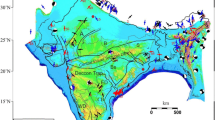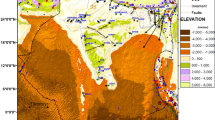Abstract
The evidence of east-west compression in northeast Japan has been reported by many investigators on the basis of geodetic, geologic and geomorphic data, but its origin still remains far from understood. In the present study we have proposed a mechanical model of tectonic loading at convergent plate boundary zones, and demonstrated its validity through the numerical simulation of internal stress fields in northeast Japan with realistic 3-D geometry of plate interfaces. At convergent plate boundary zones, in general, a part of plate convergence is consumed by steady slip along plate interfaces, and the remaining part by inelastic deformation (seismic faulting, aseismic faulting, and active folding) of overriding plates. Such a plate boundary process to be called “partial collision” can be quantitatively described by introducing a collision rate defined as c=1 — Steady slip rate at plate interfaces/plate convergence rate. By this definition, we can simply represent the mechanical process of partial collision, which includes total subduction (c=0) and total collision (c=1) as two extreme cases, in terms of steady slip rates at plate interfaces. On the basis of elastic dislocation theory, first, we numerically computed the internal stress fields in northeast Japan produced by the total subduction of the Pacific plate beneath the North American plate, however the computed stress pattern was opposite in sense to observations. Then, we computed the internal stress fields by taking c=0.1 on average, and succeeded in reproducing the observed east-west compression in northeast Japan. This indicates that the concept of partial collision is essential to understand the mechanism of intraplate tectonic loading.
Access this chapter
Tax calculation will be finalised at checkout
Purchases are for personal use only
Preview
Unable to display preview. Download preview PDF.
Similar content being viewed by others
References
Burridge, R. and Knopoff, L. (1964), Body force equivalents for seismic dislocations. Bull. Seismol. Soc. Am. 54, 1875–1888.
DeMets, C., Gordon, R. G., Argus, D. F., and Stein, S. (1994), Effect of recent revisions to the geomagnetic reversal time scale on estimates of current plate motions, Geophys. Res. Lett., 21, 2191–2194.
Geographical Survey Institute (1996), Horizontal crustal deformation in the Japanese islands, Rep. Coord. Comm. Earthquake Predict. 55, 658–665, (in Japanese).
Fukahata, Y. and Matsu’ura, M. (2005), General expressions of internal deformation fields due to a dislocation source in a multilayered elastic half-space, Geophys. J. Int. 161, 507–521.
Fukuyama, E., Hashimoto, C. and Matsu’ura, M. (2002). Simulation of the transition of earthquake rupture from quasi-static growth to dynamic propagation. Pure Appl. Geophys. 159, 2057–2066.
Hashimoto, C., and Matsu’ura, M. (2000), 3-D physical modelling of stress accumulation and release processes at transcurrent plate boundaries, Pure Appl. Geophys. 157, 2125–2147.
Hashimoto, C., and Matsu’ura, M. (2002), 3-D simulation of earthquake generation cycles and evolution of fault constitutive properties, Pure Appl. Geophys., 159, 2175–2199.
Hashimoto, C., Fukui, K., and Matsu’ura, M. (2004), 3-D Modellings of plate interfaces and numerical simulation of long-term crustal deformation in and around Japan, Pure Appl. Geophys., 161, 2053–2067.
Kato, T., El-Fiky, G. S., Oware, E. N., and Miyazaki, S. (1998), Crustal strains in the Japanese islands as deduced from dense GPS array, Geophys. Res. Lett. 25, 3445–3448.
Maruyama, T. (1963), On the force equivalents of dynamical elastic dislocations with reference to the earthquake mechanism, Bull. Earthq. Res. Inst., Tokyo Univ. 41, 467–486.
Matsuda, T. (1977), Estimation of future destructive earthquakes from active faults on land in Japan, J. Phys. Earth 25, Suppl., S251–S269.
Matsu’ura, M. (1998), Modelling and forecast of earthquake generation processes, Journ. Seis. Soc. Japan (Zisin) 50, 213–227 (in Japanese with English abstract).
Matsu’ura, M. (2004), Reproducing core-mantle dynamics and predicting crustal activities through advanced computing, J. Earth Simulator 1, 67–74.
Matsu’ura, M. and Sato, T. (1989), A dislocation model for the earthquake cycle at convergent plate boundaries, Geophys. J. Int. 96, 23–32.
Matsu’ura, M., Tanimoto, T., and Iwasaki, T. (1981), Quasi-static displacements due to faulting in a layered half-space with an intervenient viscoelastic layer. J. Phys. Earth. 29, 23–54.
Nohara, T., Koriya, Y., and Imaizumi, T. (2000), An estimation of the crustal strain rate using the active fault GIS data, Active Fault Res. 19, 23–32 (in Japanese with English abstract).
Research Group for Active Faults of Japan (1991). Active faults in and around Japan, sheet maps and inventories (revised edition), Univ. of Tokyo Press, Tokyo.
Sagiya, T., Miyazaki, S., and Tada, T. (2000), Continuous GPS array and present-day crustal deformations of Japan, Pure Appl. Geophys. 157, 2303–2322.
Sato, H. (1994), The relationship between late Cenozoic tectonic events and stress field and basin development in northeast Japan, J. Geophys. Res. 99, 22261–22274.
Tajikara, M. (2003), Vertical crustal movements of the northeast Japan arc in late Quaternary time, Dr. thesis, Univ. of Tokyo.
Takada, Y., and Matsu’ura, M. (2004), A unified interpretation of vertical movement in Himalaya and horizontal deformation in Tibet on the basis of elastic and viscoelastic dislocation theory, Tectonophysics 383, 105–131.
Yabuki, T. and Matsu’ura, M. (1992), Geodetic data inversion using a Bayesian information criterion for spatial distribution of fault slip, Geophys. J. Int. 109, 363–375.
Wesnousky, S. G., Scholtz, C. H., and Shimazaki, K. (1982), Deformation of an island arc: rates of moment release and crustal shortening in intraplate Japan determined from seismicity and Quaternary fault data. J. Geophys. Res. 87, 6829–6852.
Author information
Authors and Affiliations
Editor information
Editors and Affiliations
Rights and permissions
Copyright information
© 2006 Birkhäauser Verlag
About this paper
Cite this paper
Hashimoto, C., Matsu’ura, M. (2006). 3-D Simulation of Tectonic Loading at Convergent Plate Boundary Zones: Internal Stress Fields in Northeast Japan. In: Yin, Xc., Mora, P., Donnellan, A., Matsu’ura, M. (eds) Computational Earthquake Physics: Simulations, Analysis and Infrastructure, Part I. Pageoph Topical Volumes. Birkhäuser Basel. https://doi.org/10.1007/978-3-7643-7992-6_6
Download citation
DOI: https://doi.org/10.1007/978-3-7643-7992-6_6
Received:
Revised:
Accepted:
Published:
Publisher Name: Birkhäuser Basel
Print ISBN: 978-3-7643-7991-9
Online ISBN: 978-3-7643-7992-6
eBook Packages: Earth and Environmental ScienceEarth and Environmental Science (R0)




